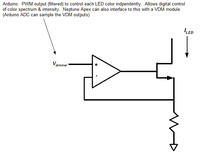No, it will step up the input voltage of course, and the output voltage is Vout=(1+R1/R2)Vref
Follow along with the video below to see how to install our site as a web app on your home screen.
Note: This feature may not be available in some browsers.


The W/L ratio is 1:1000. I don't know if it's possible in the technology that I'm using.
Your power supply of 0.45V is half of what the paper used, so you might be able to get acceptable results. If not, I would still use this LDO but with a different current limiter structure.